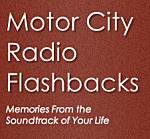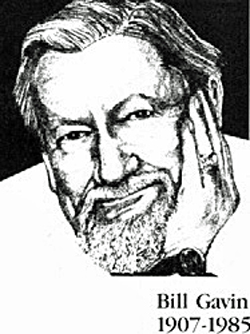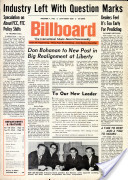 From the MCRFB NEWS archives: 1963
From the MCRFB NEWS archives: 1963
PROGRAMMING NEWSLETTER
From the Desk of Bill Gavin Billboard Contributing Editor
I D E A S A B O U T R A D I O P R O D U C T I O N have changed considerably during the past decade. The traditional concept about the producer, with his script and stopwatch, has given way to new techniques in the production of record shows in the field about.
A few deejays, in competition with big budget live programs, were forerunners of modern day production (Buffalo Bob) Smith at WNBC, Martin Block at WNEW, and Bill Randle at WERE were among the small band of pioneers in the field about adding new dimensions of sound, color, illusion and suspense to the pedestrian routine of broadcasting phonograph records.
 Today, when music and news stations are competing primarily against each other, rather than against star-studded network shows, it is through production ideas and techniques that stations attain the degree of individuality that differentiates then from their competitors. Formula radio pretty generally combines hourly five-minute news, periodic temperature reports and weather forecasts, frequent (and seemingly incessant) references to the station call letters, and upward of a dozen records each hour. From 10 to 15 minutes per hour are devoted to commercials.
Today, when music and news stations are competing primarily against each other, rather than against star-studded network shows, it is through production ideas and techniques that stations attain the degree of individuality that differentiates then from their competitors. Formula radio pretty generally combines hourly five-minute news, periodic temperature reports and weather forecasts, frequent (and seemingly incessant) references to the station call letters, and upward of a dozen records each hour. From 10 to 15 minutes per hour are devoted to commercials.
B Y F A R T H E L A R G E S T amount of today’s radio production is devoted to the presentation of these ingredients. Station identifications is made musically by jingles. News is introduced by fanfares or jingles, and is occasionally interspersed with code or ticker sound effects, to create the illusion of world-wide and instantaneous coverage. Such features as the “discovery,” and even time and weather, also have their own special themes and sound effects.
Production Outfits

M AN Y O F T H E S E P R O D U C T I O N aids are prepackaged by large production outfits that specialize in such things. New York and Hollywood, with their huge reservoirs of talents, provide the main sources of production packages, but non-unionized areas such as Texas offer lower costs plus frequently good results. In a few cases, the program director deserves much credit for creative ideas that go into the jingle package, but generally the production company originates the ideas and syndicates them in noncompeting areas.
Packaged production aids have been standard for quite some time. More recently, the emphasis has been on local station production. A number of important stations now assign a full-time individual to direct production. In addition, more emphasis is being placed on making individual disks jockeys responsible for production gimmicks on their shows.
The station’s production director is mostly occupied with recording station promotions and special features. He submits original ideas to his program director for handling contests, phone interviews, on-the-spot tapes, and so on. More and more, the production director is being made responsible for what is loosely called, for want of a better name, the station’s “public image.”
Challenge In Future
T H E D I S K J O C K E Y , as his own production man, faces the biggest challenge in the years immediately ahead. It is impossible to speak of deejay production skills without mentioning the legendary Frank Ward, now station manager of WVON, Chicago. Stories are still told of Frank’s console of four or five turntables, his chest mike, his flawless cuing and timing, and how he scorned a chair — always working on his feet. Several deejays of more recent vintage learned their trade by watching and listening to him.
One program director recently told me: “I don’t want my jocks to ad lib a good new idea. If they think of it during today’s show, I tell them to hold it off and work on it for tomorrow’s show. That way, they always know how to handle it and whether it will really fit it.”
This statement illustrates today’s growing emphasis on the disk jockey ‘s advance preparation for each show. The trend in today’s radio, regardless of station music policy, is toward a greater accent on showmanship. The success of tomorrow’s disk jockey is likely to be determined not by his voice or his selection of music, but how he plans and presents each show. This medium, with tape cartridges, wild tracks, transcribed bridges and sound effects, offers him a wider range of flexibility and choice. How he selects and uses his materials will have much to do with his ability to attract a sizable audience.
Music and news are still, and will continue to be, radio’s main ingredient. Production offers the plus values that can make the difference. END
___
(Information and news source: Billboard; December 7, 1963)
![]()
